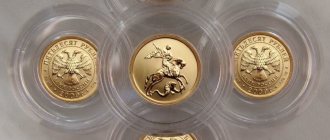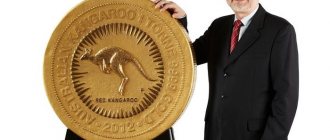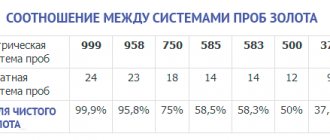Advertisement - Continued below
For many centuries, gold has been not only a precious material, but also an equivalent of value, since it acts as a guarantor of payments both within the country and between different states. Gold has always been highly convertible, providing stability to the economy and the currency linked to it.
On the global economic stage, there are many countries that can compete in terms of gold reserves in their government financial institutions. We present to you the ranking of the richest countries in gold reserves according to the World Gold Council as of June 2015.
The concept of gold reserves, how gold and foreign exchange reserves are formed on its basis
First of all, the gold reserve is one of the components of gold and foreign currency reserves. Affects its functions. A gold reserve is a precious metal that is located in the department of the Central Bank or the Ministry of Finance (it is structured differently in different countries). Its cost depends on foreign exchange market quotes. The universal international unit that allows you to keep track of precious metals is the troy ounce.
Gold bars
The share of the country's gold reserves makes up a certain part of the gold and foreign exchange reserves. But it is always different, which depends on the solvency of the state, its status on the world stage and literally on the amount of precious metal. The higher the share of monetary gold, the greater the country’s influence on interstate relations. Typically, gold reserves held in state accounts are replenished in different ways:
- by mining precious metals;
- acquisition method.
France
TOP 10 countries with the largest gold reserves. Photo: oklanding.me
Official gold reserve: 2436 tons
Share of precious metals in the country’s gold and foreign exchange reserves: 61,1%
In 2022, Reuters reported that the Bank of France had begun working to improve the state of its gold reserves. This will help France achieve new successes in international trade.
India
- Tons: 657.7
- Percentage of gold and foreign exchange reserves: 7.5%
It is no surprise that Bank of India has one of the largest gold deposits in the world. With a population of 1.25 billion, South Asia is the second largest consumer of precious metals and one of the most reliable drivers of global demand.
China
- Tons: 1948.3
- Percentage of gold and foreign exchange reserves: 3.4%
In the summer of 2015, for the first time since 2009, the People's Bank of China began sharing gold purchasing activity on a monthly basis. Although China has the sixth-largest foreign exchange reserves, the yellow metal makes up only a small portion of its total reserves, just 3.4%.
Don't miss: 11 most expensive cities in the world in 2022
Since December 2022, China has purchased almost 100 tons of gold.
Top 10 countries by the number of gold deposits
The most common way to extract the mineral is by washing sand in natural springs. Their sizes are microscopic, and particles weighing about 1 gram are called “nuggets.”
Netherlands
Most of the reserves are located in the southern part of the country near the Waalserberg mountain. Only a few people are searching for the chemical element in the Netherlands. Most often, this is an industrial organization that carries out work on mineral extraction. Or a visiting group that conducts searches in cities. The total number of reserves is approximately 612,000 tons.
India
India is known for its love for gold jewelry. Therefore, a lot of material is imported into the country from other countries. Non-ferrous metallurgy cannot fully satisfy the needs of the state. Thanks to the discovery of a new field in northern India, analysts predict production of 668,000 tons in 2021.
Japan
Japan's gold reserve is under the control of the country's Ministry of Finance. Despite the pandemic, the resource remains in demand in the state. Therefore, gold mining organizations operate in the same mode as before the crisis. According to analytical data for 2022, the total reserve amount is 765,000 tons.
Switzerland
Research from the Statista portal says that Switzerland is so rich in gold reserves that there is a bunker in one of the country’s villages to store the mined resource. The storage facility is under constant surveillance and security control. The location is highly classified and not known to all members of the Swiss government. The total number of deposits is 1 million 040 000 tons.
China
China's reserve stock remains unchanged compared to previous years. By the end of 2022, the number of deposits will be about 1 million 948,000 tons. Due to the coronavirus and the tense situation between the United States and China, prices for Chinese gold have increased significantly. According to analysts, the cost may triple by the end of the second half of this year.
Gold and foreign exchange reserve: what it is, what it consists of, functions
The state owns various means that contribute to the formation of its status. They are united by the concept of gold and foreign exchange reserves or gold and currency reserves. This is the name given to assets that have a high degree of liquidity. They are of great value not only for the state, whose property is the gold and foreign currency reserves, but also for other countries.
The gold and foreign exchange reserve is one of the main levers of pressure on the processes shaping interstate relations.
On the territory of Russia today a combined structure of gold and foreign exchange reserves is used. The Central Bank of the Russian Federation, the Ministry of Finance, and the Treasury contribute to this. For comparison, other countries use different management and control systems. For example, in the UK the Ministry of Finance is decisive. The Central Bank in this case is the executive body. If we consider Japan, then they also have a combined system that Russia uses. The US gold and currency reserves are formed according to a similar scheme.
Gold and foreign exchange reserves
Gold and foreign exchange reserves are a concept that includes several main areas:
- funds in foreign currency: this can be not only cash (dollars, euros, etc.), but also other means of payment, for example, reserves in correspondent and unallocated metal accounts, securities, deposits, but provided that the maturity date – up to 1 year, and different forms are allowed (gold, loans from high-reliability banks), this also includes debt securities;
- special drawing rights - the concept refers to assets that were issued for circulation by the International Monetary Fund (IMF);
- position in the IMF - a reserve that is located in the IMF and corresponds to the amount of the initial contribution that the country pays upon admission, if there is a need to sell or purchase means of payment of this category;
- monetary gold: this group includes precious metals of high standard (from 995 and above, but more often - 999/1000), it can be gold, platinum or silver, and the form of release of precious products is always the same (coins, bars), this direction is the most popular, directly affects the position of the country’s national currency.
Germany
- Tons: 3363.6
- Percentage of gold and foreign exchange reserves: 75.6%
In 2022, Germany completed a four-year repatriation operation to recover a total of 674 tons of gold from its own deposits at the Bank of France and the Federal Reserve Bank of New York. The first step was announced in 2013 and is expected to be completed in 2022.
Don't miss: What you should know about being a food delivery driver
Although gold demand has weakened in 2022 after reaching an all-time peak in 2016, gold investment in the European country has risen steadily since the global financial crisis.
Why did gold become the universal equivalent of value?
What is the reason for such a high popularity and demand for this precious metal? According to K. Marx, gold was one of the first metals discovered by people in their time. First extracted from the sands of the Arabian desert in the form of grains and small nuggets, gold served as a powerful stimulus for the development of Ancient Egypt.
The answer to the above question can be found by conducting a small thought experiment. One has only to distract oneself from everything around him for a second and imagine gold in any form, and immediately many associations of the most diverse nature arise. And this is not without reason. After all, gold is of great rarity and amazing beauty.
, providing a special aesthetic and emotional impact on a person. Even more expensive platinum cannot compete with it in this matter.
Given its excellent properties:
- strength,
- plastic,
- resistance to external aggressive chemical influences,
- possibility of long-term storage,
- divisibility,
- widespread (albeit in extremely small quantities and at considerable depth) in all parts of the world;
- high cost compatible with ease of storage,
…we have to admit that this chemical element plays the role of a kind of connecting link
when carrying out a variety of financial transactions and relationships.
Relations carried out at any
historical time throughout the entire territory of our planet!
Which in itself is already a unique fact that speaks of special universality
gold as a chemical element and a means of financial circulation.
Gold as one of the very first financial instruments
As production develops and strong trade links are established, the importance of gold increases. Thus, ensuring the economic and political flourishing of the eras of the Ancient, Middle and New Kingdoms
, thanks to the presence of metal deposits in Nubia, gold actually took on the role of a means of purchase and payment.
And all because there was simply no other currency (with the exception of a number of other precious metals) in those days. Commodity relations based on the exchange of some natural products in the form of livestock, grain, fruits and vegetables for others, again required the creation of a system of price and value, the measure of which could only be gold. With the emergence of the state and the accumulation of wealth, both in private hands and in the treasury, it took on the role of a measure of values. After all, it was with its help that many countries’ expenses for public needs were covered.
Around the same time, the prototypes of modern coins appeared - gold bars of a certain weight with the name of the ruler stamped on them
. The first of them, apparently, was the Egyptian pharaoh Menes I. Over time, the role of precious metals (gold and silver) in monetary circulation increased, which was greatly facilitated by great geographical discoveries and the discovery of ever new gold deposits.
Gold in reserve
Modern registered government reserves of gold, concentrated in the Central banks of various countries and IMF reserves, amount to more than 32 thousand tons. The population has even larger amounts of gold in the form of jewelry and coins.
Gold reserves increase due to gold mining. About one percent of surface gold was mined in the first five years of the California Gold Rush.
Interestingly, according to scientists, all the gold on Earth is of cosmic origin. It is believed that gold ore deposits were formed about 4 billion years ago. It was then that a long golden meteor shower rained down on the Earth.
In the early 2000s, world reserves of mined gold amounted to about 150.4 thousand tons, which were distributed as follows:
- about 30 thousand tons in state central banks and international financial organizations;
- 79 thousand tons in jewelry - the leader and favorite in this case is precisely 750 gold;
- 17 thousand tons in electronics and dental products;
- 24 thousand tons in investment savings.
In 2009, the total world reserves of mined gold already amounted to 165 thousand tons. At $1,000 per troy ounce, the total value of that gold would be more than $5 trillion. About 20% of all onshore gold is held by central banks and official institutions as reserve assets.
Exchange-traded funds hold 1,750 tons of gold for private and non-private investors.
Netherlands
- Tons: 612.5
- Percentage of gold and foreign exchange reserves: 71.4%
The Dutch central bank has announced that it will move its gold vaults from Amsterdam outside the city, about an hour's drive from the capital, citing excessive security measures at their current location. This seems strange given that the bank recently repatriated a large amount of gold from the US.
The largest gold mines in Russia
The central active deposits of the Russian Federation belong to the primary type; they have been exploited since the times of the Soviet Union. These are the following mines:
- The Berezovskoe primary deposit, where mining has been carried out since the mid-18th century, continues to this day.
- Vorontsovsky mine, located in the Sverdlovsk region. Its operation began relatively recently - in 2000. It is worth noting that it was here that the technology of heap leaching of gold at subzero ambient temperatures was tested for the first time.
- Sukhoi Log is a substantial deposit in Eastern Siberia, notable for its impressive gold reserves, but with a low gold content in the ore. At the moment, there is no industrial development on it.
- The Natalka deposit is a rich mine, which is also not used in our time.
The Russian Federation does not hold the leading position in gold reserves, however, given the gigantic area of unexplored lands in the North, the situation may change in the future.
The increase in the rate of gold mining is associated with the development of technology for obtaining gold from rock. Thus, in 2015, the global production of pure gold amounted to more than 3,200 tons - this figure was registered as a historical maximum.
You might be interested in: History of gold mining









